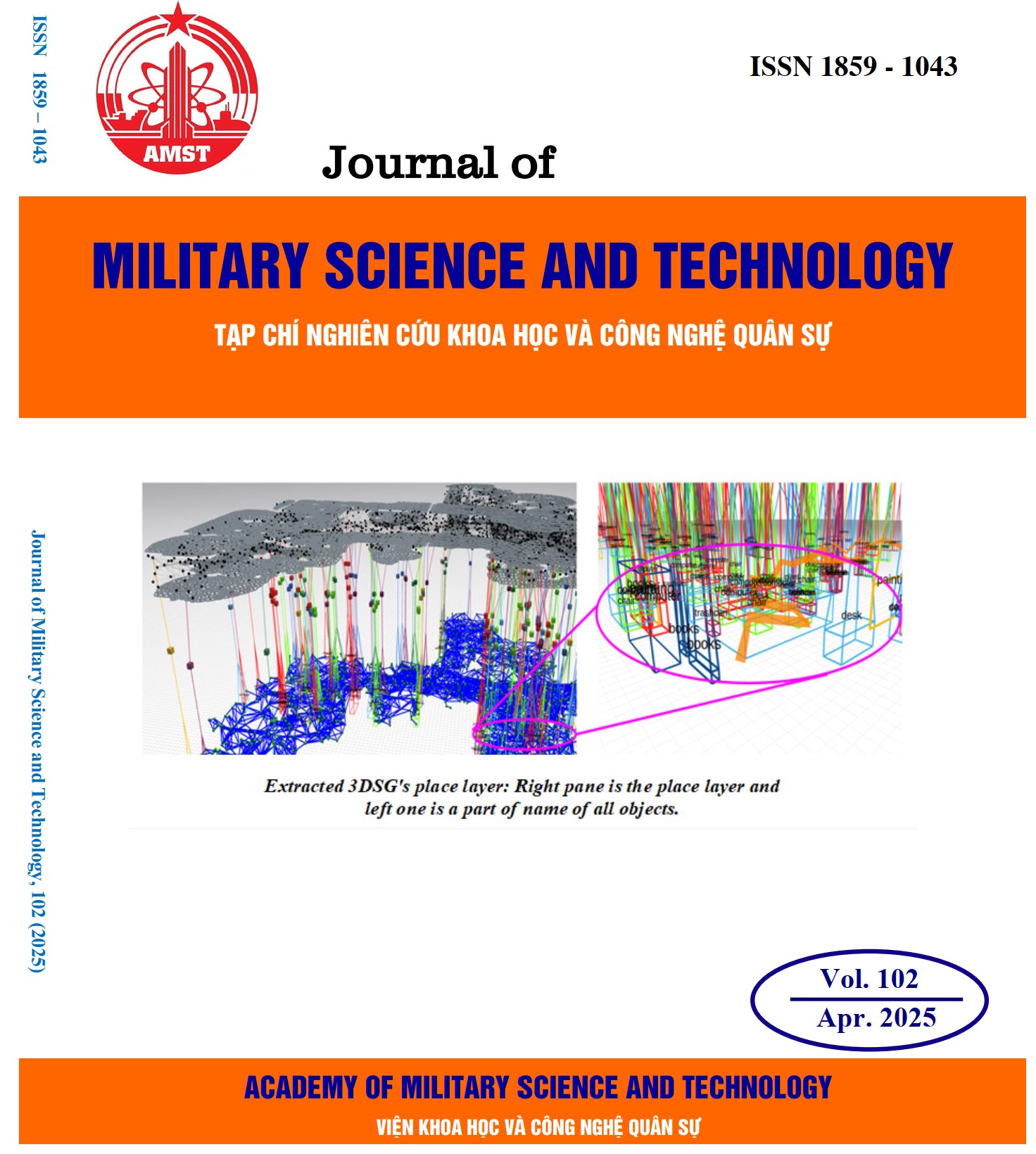Nghiên cứu thử nghiệm và đánh giá hiệu quả ngụy trang ảnh nhiệt của vật liệu tiên tiến cho phương tiện cơ giới
624 lượt xemDOI:
https://doi.org/10.54939/1859-1043.j.mst.102.2025.109-117Từ khóa:
Ngụy trang; Ngụy trang ảnh nhiệt; Phương tiện cơ giới; Năng lượng phát xạ; Tương đồng mức xám.Tóm tắt
Các phương tiện cơ giới có động cơ sinh nhiệt cao và lớp vỏ thường được làm bằng các vật liệu kim loại có khả năng hấp thụ và phát xạ nhiệt lớn. Vì lý do đó nên các hệ thống trinh sát ảnh nhiệt có thể dễ dàng phát hiện hoặc nhận dạng mục tiêu. Để giảm độ tương phản nhiệt, một phương pháp hữu hiệu là áp dụng lớp phủ có khả năng làm suy giảm phát xạ nhiệt từ các phương tiện cơ giới. Tuy nhiên, trong nước hiện vẫn chưa có nghiên cứu nào đánh giá hiệu quả của lớp phủ ngụy trang nhiệt cho các phương tiện cơ giới. Do đó, bài báo này đã tập trung vào việc nghiên cứu phân tích thành phần vật liệu phủ tiên tiến, đồng thời áp dụng thử nghiệm và đánh giá hiệu quả ngụy trang ảnh nhiệt của nó cho phương tiện cơ giới tại Việt Nam. Kết quả của bài báo sẽ là cơ sở để nghiên cứu chế tạo vật liệu mới và áp dụng ngụy trang ảnh nhiệt hiệu quả cho các phương tiện cơ giới trong nước.
Tài liệu tham khảo
[1]. Watson K Geological, “Application of Thermal Infrared Images”, Proceeding of the IEEE, 63: 128~137, (1975). DOI: https://doi.org/10.1109/PROC.1975.9712
[2]. Liang F.R. et al, “Improving anti-infrared radiation and heat insulation by potassium hexatitanate whisker-doped A12O3-SiO2composite xerogel”, J.Royal Society Open Science, 12(5): 180787-180787, (2018). DOI: https://doi.org/10.1098/rsos.180787
[3]. N.T. Cam et al, “Camouflage in countering optical-electronic reconnaissance”, Training curriculum for postgraduate students of the Academy of Military Science and Technology, People's Army Publishing House (2023).
[4]. Meng Z.H. et al, “Research progress on photonic crystal infrared stealth materials technology”, J.Acta Armamentarii, 37(8): 1543-1552, (2016).
[5]. D. Peric et al, “Thermal Imager Range: Predictions, Expectations and Reality”, Sensor, 19(15), 3313, (2019). DOI: https://doi.org/10.3390/s19153313
[6]. C. Plesa et al, “The use of infrared radiation for thermal signatures determination of ground targets”, Rom. J. Phys. 51, pp.63–72, (2006).
[7]. J.G. Hixon et al, “Target detection cycle criteria when using the target task metric” SPIE 5612, pp. 275–276, (2004). DOI: https://doi.org/10.1117/12.577830
[8]. Zhang Weigang et al, “Preparation and characterization of Ge/TiO2 one-dimensional photonic crystal with low infrared-emissivity in the 8-14 um band”, J.Materials Research Bulletin, 124: 110747, (2020). DOI: https://doi.org/10.1016/j.materresbull.2019.110747
[9]. Liu Dongqing, “Application of variable infrared-emissivity materials to spacecraft thermal control”, Journal of National University of Defense Technology, 34(2): 145-149, (2012).
[10]. J. Berela, M. Kastek, “Measurement and Analysis of the Parameters of Modern Long-Range Thermal Imaging Cameras”, Sensor (17), 5700, (2021).
[11]. F.B. Olsen, “Methods for evaluating thermal camouflage”, A FFI Report No. RTO-MPSCI-145, 2005.
[12]. A. Roglski et al, “Infrared Detectors, An Overview”, Inf. Phys. Technol. 43, pp. 187-210, (2002). DOI: https://doi.org/10.1016/S1350-4495(02)00140-8
[13]. Eisner Leonard et al, “Spectral Radiation of Sky and Terrain Wavelength between 1 and 20 µm. Terrain Measurements”. Journal of the Optical Society of America, 52: 201~209, (1962). DOI: https://doi.org/10.1364/JOSA.52.000201
[14]. J. Berela, M. Kastek, “Measurement and Analysis of the Parameters of Modern Long-Range Thermal Imaging Cameras”, Sensor (17), 5700, (2021). DOI: https://doi.org/10.3390/s21175700
[15]. William L. Wolfe, “Handbook of Military Infrared Technology”, Office of Naval Research Department of the Navy, (1965).
[16]. N.N. Son et al, “A high-accuracy measurement method of surface emissivity using a spectroradiometer SR-5000N”, Proc. of 8th CASEAN, Vinh, pp.674, (2023).
[17]. M. Honner and P. Honnerová, “Survey of emissivity measurement by radiometric methods”, Appl. Opt. 54, 669-683 (2015). DOI: https://doi.org/10.1364/AO.54.000669







